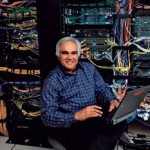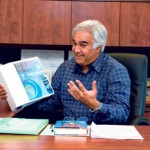Bringing State Government
Sonny Bhagowalia, the state’s new chief information officer, is changing the way government works and how it thinks about itself, and even more, how government can better serve the people of Hawaii
By any measure, Sanjeev “Sonny” Bhagowalia, Hawaii’s first state chief information officer, defies expectations.
First, one expects a mousy computer nerd to head up what is ostensibly the state’s IT department. Instead, one finds an ebullient man whose voice booms down the hall as you approach his office, and whose infectious smile has any room he is in giggling along with him as he gleefully explains dashboards and hackathons.
- Sonny Bhagowalia, the state’s new chief information officer, is changing the way government works and how it thinks about itself, and even more how government can better serve the people of Hawaii
- With wife Daisy and sons Rajeev (top, right) and Sanjay | Photo courtesy Bhagowalia family
- Bhagowalia will introduce six mobile apps in June | Nathalie Walker photo
Once inside his office, one pictures a bank of mainframes with the only light coming from that emanating from the video screens surrounding him.
Instead, it is open windows looking out at St. Andrew’s Cathedral (“I look out there and confess my sins every day!” says Bhagowalia), and the only computer is a simple MacBook Pro that one would expect to find sitting on a college freshman’s dorm room bed.
But he is a Washington insider, recently working for the Obama administration. There is no way he can understand how we do things out here.
Yet his speech is riddled with Hawaiian-language phrases, and his rallying cry is “aloha with urgency.”
Well, if he does fit in here, then there is no way he is going to get anything done. He must just be another career government worker happy to wile away the days until he gets that swollen pension.
Well, there one would be the most wrong. Upon taking the job, he said he would put together a plan to fix our decades-out-of-date computer system in two years.
He got it done in one. His plan has been so revolutionary that it earned him recognition as part of the 2013 Federal 100 Awards by Federal Computer Weekly. He was the only recipient at the state level to be so honored.
Bhagowalia understands that public servants are there to (gasp!) serve the public. He talks of the 220 business functions they provide as a state government and how unwieldy they were when he arrived.
“One hundred and fifty of those services are resident or citizen-facing, but less than 5 percent are online, so everyone instead has to wait in line – long lines,” says Bhagowalia, who does not blame his predecessor, namely the state comptroller, who Bhagowalia says had plenty to deal with besides the computer issues.
“Every time they go through a process, someone asks them if they brought this piece of paper, and they say, ‘Oh, no!’ and you go to the back of the line. That is what the problem is: What if we had all of that on a website and there is only one way to do it? When you can do one, two and three, and then you are done, it is easier to deal with the government in that way.”
His is an uphill battle. The computers, the programs and the interfacing are antiquated, some dating back to the 1980s because of a lack of attention and funds provided by the state.
“We as a state only spent 1 cent on the dollar for technology for the past 30 years,” says Bhagowalia, who received his M.S. from Syracuse University. “We should have been spending 3 to 5 cents on the dollar. So guess what? Our technology is behind the times. I am just asking for one more cent on the dollar – that is still well below what we need, but with that we can really start to improve it.”
His plan outlines how he doesn’t want to drag us into the modern age, but to leapfrog over all that lost time to make us a leader in technology. He points to Singapore and South Korea as places that were adrift but have now turbocharged their economy through modernizing and helping businesses acquire what they need.
“Everything we do in our lives these days in business requires technologies, but it is more than technology, it is about information,” says Bhagowalia, who began his career in the private sector serving as a senior principal engineer with Boeing. “They need information, they need it to be mobile and to have it at their fingertips right now. You have heard of news you can use; we believe in information you can use.”
He has six mobile apps he will unveil in June, giving the public access to information that previously was available only by visiting the varied offices. Soon, tax information, education updates and even the population in our homeless shelters will be accessible instantly on one’s mobile device.
The first example of how this information can be used can be seen in a project done recently by some of Bhagowalia’s interns from HPU. Simply using the information now available on the Hawaii.gov website, they put together a database where one can track fuel prices, revenue from tourist expenditures and money collected from the cigarette tax.
By opening up all the data the government collects, one is arming businesses with the information they need to be successful.
“This is what you want – anyone can do this!” says Bhagowalia of the site at data.hpu.edu. “You don’t know where the next brilliance is – anyone can do this. People have innate skills, we just need to bring it out. This is what can happen with open data.”
He began this evolution to online government in Washington, D.C., which received an unprecedented 75 approval rating for the public’s experience with government services.
As he sees it, we need to reverse our thinking on what the government provides for the public.
“In the past, the government would say, ‘You will like what we give you,’ but what about what we want?” asks Bhagowalia, who also helped update IT for the FBI and U.S. Department of the Interior. “You have heard about these hackathons so that citizens can engage with us and say what else we should be doing.”
“Hackathon” is an insider term used to describe when one opens up something to everyone to contribute, usually involving software. But Bhagowalia believes it can work in all sectors – and it seems his boss believes in it, too.
“Sonny has built confidence and momentum across government agencies, industry leaders and the people of Hawaii toward modernizing our state’s aging technology infrastructure and systems – a long-term investment that will improve government and business processes,” says Gov. Neil Abercrombie. “His work transcends technology into a new way of doing business in Hawaii and providing public services.”
Helping the general public is only half the job, though. There are still 70 services the state performs that look internally, and everywhere he looks he sees redundancies and unnecessary steps that only make the government more cumbersome and costly.
He cites the state Department of Accounting and General Services, which is housed next door to his Alakea Street office. DAGS processes 22 million pieces of paper each month.
“In their data center you have these big mainframes, and right next to it you have stacks of paper – and in 2013, that’s not right,” says Bhagowalia. “One of the internal-facing services is Enterprise Resource Planning, which does the management of everything in our state regarding human resources, budget and finance, payroll, assets and grant management, how we procure stuff – all of that needs to be managed better.
“Right now it is all paper, and we don’t even know what the budget is, we just make spreadsheets and link them together and publish them up. We want a financial system where, at any point in time, you can see real costs. You should have a leave system where you can go in at anytime and see how much leave you have.
“Now we have forms, you do it by hand and turn it in, then another person takes that paper and puts it into another system. Look what we are doing here, it’s crazy! This has got to stop. If all of this was available online, you could just ask the system. We have to stop all this paperwork and protect our forests.”
His fervor is evident, and naysayers beware. He was told he would never get the funding he needed, but instead he got $25 million in his first year. From his decades of public service, he has learned that it isn’t always getting the new software in place that is toughest; it is getting the people to buy in.
“The hard one is organizational culture, getting people to work together across organizational lines so that they know they can really change,” says Bhagowalia. “How do you get them to come in and trust us? Come up with ideas, implement your ideas; you don’t have to wait on us.”
In order to get people to buy in, however, he has to earn their trust that he can truly make this revolution happen, and he believes that when they unveil the new site, myhawaii.gov, with its personalized dashboards and updates, he will have done just that.
“Previously, you would go to our site and you couldn’t find anything, you would just give up. We want people to not give up and have a pleasant experience,” says Bhagowalia.
“Now you will be able to see a service and interact with that service directly, taking away the paper-based silos and waiting in line, and taking it online, and everything being interactive online and mobile.”
That is something that none of us would have ever imagined, but with Bhagowalia at the helm, it is time we expected the unexpected.






